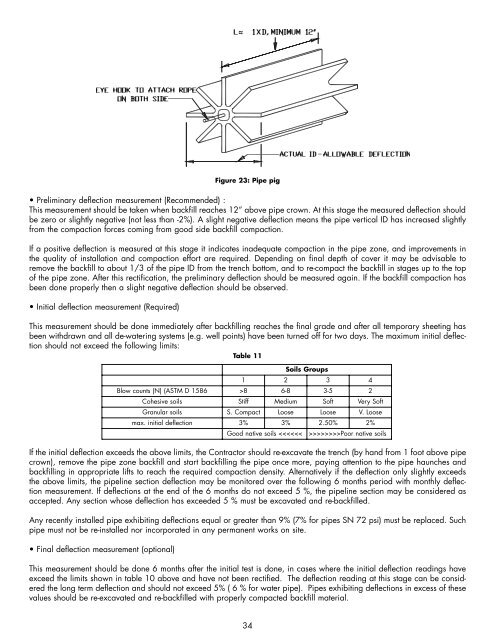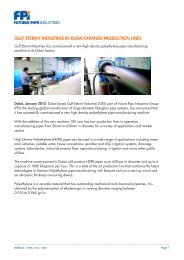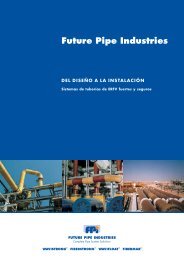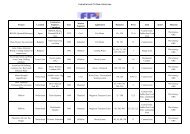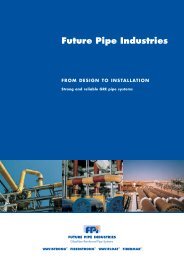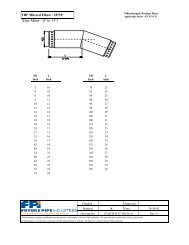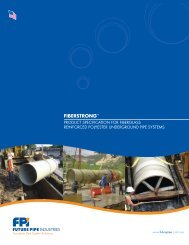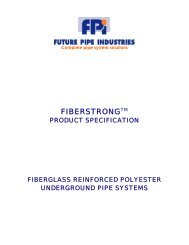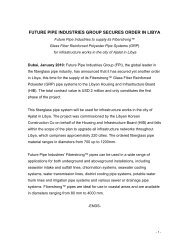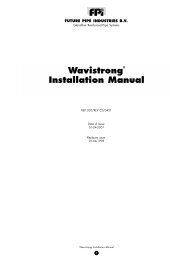Untitled - Future Pipe Industries
Untitled - Future Pipe Industries
Untitled - Future Pipe Industries
Create successful ePaper yourself
Turn your PDF publications into a flip-book with our unique Google optimized e-Paper software.
Figure 23: <strong>Pipe</strong> pig<br />
• Preliminary deflection measurement (Recommended) :<br />
This measurement should be taken when backfill reaches 12” above pipe crown. At this stage the measured deflection should<br />
be zero or slightly negative (not less than -2%). A slight negative deflection means the pipe vertical ID has increased slightly<br />
from the compaction forces coming from good side backfill compaction.<br />
If a positive deflection is measured at this stage it indicates inadequate compaction in the pipe zone, and improvements in<br />
the quality of installation and compaction effort are required. Depending on final depth of cover it may be advisable to<br />
remove the backfill to about 1/3 of the pipe ID from the trench bottom, and to re-compact the backfill in stages up to the top<br />
of the pipe zone. After this rectification, the preliminary deflection should be measured again. If the backfill compaction has<br />
been done properly then a slight negative deflection should be observed.<br />
• Initial deflection measurement (Required)<br />
This measurement should be done immediately after backfilling reaches the final grade and after all temporary sheeting has<br />
been withdrawn and all de-watering systems (e.g. well points) have been turned off for two days. The maximum initial deflection<br />
should not exceed the following limits:<br />
Table 11<br />
If the initial deflection exceeds the above limits, the Contractor should re-excavate the trench (by hand from 1 foot above pipe<br />
crown), remove the pipe zone backfill and start backfilling the pipe once more, paying attention to the pipe haunches and<br />
backfilling in appropriate lifts to reach the required compaction density. Alternatively if the deflection only slightly exceeds<br />
the above limits, the pipeline section deflection may be monitored over the following 6 months period with monthly deflection<br />
measurement. If deflections at the end of the 6 months do not exceed 5 %, the pipeline section may be considered as<br />
accepted. Any section whose deflection has exceeded 5 % must be excavated and re-backfilled.<br />
Any recently installed pipe exhibiting deflections equal or greater than 9% (7% for pipes SN 72 psi) must be replaced. Such<br />
pipe must not be re-installed nor incorporated in any permanent works on site.<br />
• Final deflection measurement (optional)<br />
Soils Groups<br />
1 2 3 4<br />
Blow counts (N) (ASTM D 1586 >8 6-8 3-5 2<br />
Cohesive soils Stiff Medium Soft Very Soft<br />
Granular soils S. Compact Loose Loose V. Loose<br />
max. initial deflection 3% 3% 2.50% 2%<br />
Good native soils >>>Poor native soils<br />
This measurement should be done 6 months after the initial test is done, in cases where the initial deflection readings have<br />
exceed the limits shown in table 10 above and have not been rectified. The deflection reading at this stage can be considered<br />
the long term deflection and should not exceed 5% ( 6 % for water pipe). <strong>Pipe</strong>s exhibiting deflections in excess of these<br />
values should be re-excavated and re-backfilled with properly compacted backfill material.<br />
34


